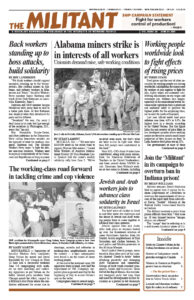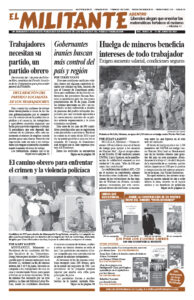The brief wave of clashes in Israel in mid-May shows the challenges and the desire of Jewish and Arab working people there to come together to advance their class interests.
Attacks against Jews and Arabs alike took place as tensions heated up over the threatened eviction of some Palestinian families from the Sheikh Jarrah neighborhood of East Jerusalem and clashes between Israeli police and Muslim protesters at the Al-Aqsa Mosque.
Small rightist Jewish groups, many bused in from other parts of the country, chanted “Death to Arabs” before attacking passersby and damaging Arab businesses and cemeteries. Groups of Arab youth attacked synagogues, homes and businesses. Some waved the flag of Hamas, the reactionary bourgeois party that runs Gaza and used the developments in East Jerusalem as a pretext to lob thousands of rockets at residential areas in Israel. Most people in Israel, Jews and Arabs alike, were appalled at the violence.
Most Arab citizens of Israel — some 20% of Israel’s 9 million people — live in all-Arab towns. There are a handful of “mixed” cities, including Acre, Lod, Ramla, Haifa and Jaffa. But most contact between Jews and Arabs is on the job and through their unions, Yaniv Bar Ilan, spokesperson for Koach la Ovdim (Power to the Workers), a union federation with some 30,000 members, told the Militant by phone from Tel Aviv June 3.
Jews and Arabs work side by side in hospitals, factories, tourist centers and other workplaces. Arab working people face discrimination in jobs, housing, education, access to social services and more.
Many lower-paying jobs — like in agriculture — are mostly filled by migrant workers from Thailand and China or Palestinians. Construction workers are often Palestinians from Jerusalem and the West Bank. “And there is a big difference in their conditions,” Bar Ilan said. Few of these workers are members of any union.
“Arab workers in Israel work longer hours, and get lower wages,” Dr. Fawzi Shaaban, for the Palestine General Trade Union Federation, said from East Jerusalem June 8.
‘Class brothers and sisters’
Koach la Ovdim distributed a flyer the week of the attacks at the workplaces it organizes. “We are class brothers and sisters,” it said, “and this violence does not serve any of us.”
“These riots did not penetrate into the working class,” Avi Gabbay, chairman of the Tiberias Regional Labor Council of the Histadrut, Israel’s largest trade union federation, told the Militant June 5.
Gabbay said that was not the case in 2000 during the “second intifada,” a wave of protests by Palestinians in the West Bank, Gaza and inside Israel. At one point, “tensions between Jewish and Arab workers were so severe, that a hotel manager requested that I come down,” Gabbay said. “We needed to have special discussions between Jews and Arabs to mitigate the situation. Not this time. Relations on and off the job are good.”
While Tiberias is not a mixed city, Muslims, Christian Arabs, Druze and others come to work from nearby villages. This is reflected in the union. “On the elected workers committees there are many Arabs, as are many of the shop stewards,” Gabbay said.
The city of Acre (Acco) is nearly 32% Arab, the highest percentage of any mixed city. The Acco Theater Center, established in 1985 to promote artistic freedom and host music, dance and plays in Hebrew and Arabic, was severely damaged during the rioting.
“We’re not sure that those who threw those little bottles that burn realized they were throwing it at the theater,” because the entrance is on the other side of the building, Smadar Yaaron, a founder of the theater, said by phone June 7.
The morning after, she said, “the Palestinian residents came to help clean,” as well as some Jewish residents. “Most people, Jewish and Arab, in Acco don’t want the violence, they want to live together,” Ziwar Bahlul, a Palestinian musician and actor who is part of the theater, told the Militant.
Gangs from outside the city were joined by some local Arab youth. “Most of them are not working and are from poorer families,” Bahlul said. “They want to let the other side know that they’re not happy.” Arab youth face high unemployment and harassment from the police. There is also resentment over “gentrification,” Yaaron said, as more Jewish-owned businesses have moved into the traditionally Arab “Old City.”
Anti-Arab attacks in Acre were by outsiders who came in buses, Bahlul said, including from La Familia, the notorious racist fan club of the Beitar Jerusalem soccer team. “The Jewish people in Acre came out and told them to go away. They protected their Arab neighbors,” he said.
Fadi Kasem, a 28-year-old nurse, and other Arab Acre residents headed to the scene of the May 12 rioting to try to stop the violence. They found Mor Janashvili, an Israeli Jew, being severely beaten by a mob of young Arabs.
Kasem shielded Janashvili from the attackers, bandaged his wounds and made sure he made it to the hospital.
“We have a system in place” to act when tensions break out, Kasem told the Militant by phone. At the same time, Kasem said, “the government needs to treat all citizens as equal” if it’s to prevent attacks in the future.
All these reports indicate the potential for collaboration between Jewish and Arab workers, including in labor struggles and broader efforts to press Israeli leaders and leaders of Palestinian groups to negotiate and agree to recognize both a sovereign Palestinian state and Israel.
When Kasem went to the hospital to check up on his new friend, Janashvili said he won’t return to Acre any time soon.
“Don’t talk like that,” Kasem replied. “In 2008, when there were severe riots in Acre, people did not believe coexistence would return.” But it did. “I will take you to eat hummus in Old Acre,” Kasem said. “My home is your home.”

